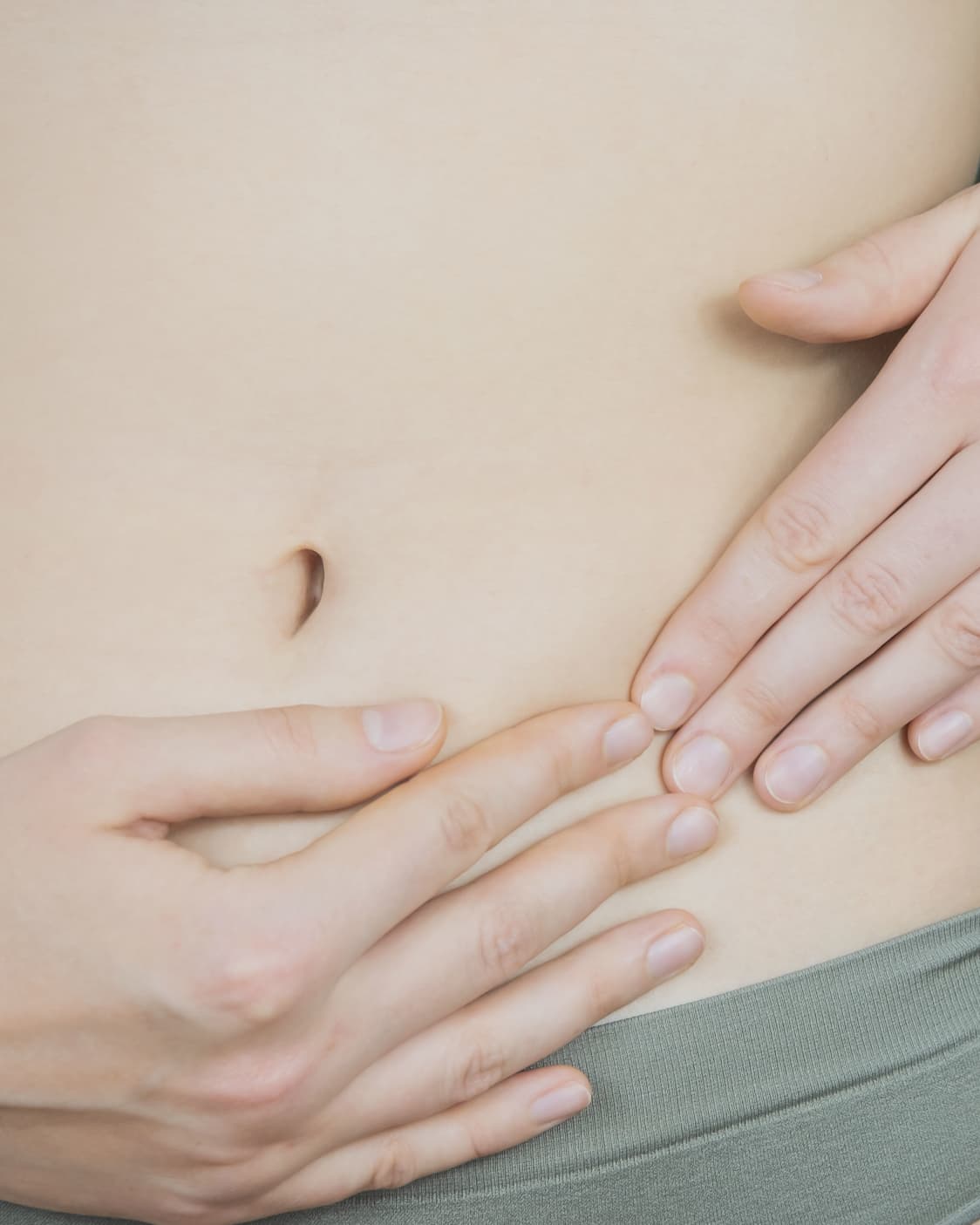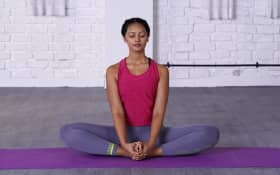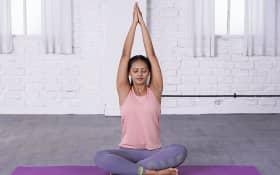
About this pack
Polycystic ovary syndrome (PCOS) is a hormonal condition common among women in their reproductive age. Though there is no cure for PCOS, the symptoms are manageable through the practice of yoga. The sessions in this pack focus on stretching and relaxing the body and mind, to reduce pain and diminish stress, further leading to balanced hormones. Benefits: - Provides pain relief & comfort - Promotes relaxation - Helps stabilize hormones - Mood enhancer
What is Yoga?
Yoga is a spiritual practice that is a type of discipline which makes use of breath control,
meditation and specific body postures that are performed to improve health. It relaxes
the muscles and different parts of the body instantly, and in general, a yogic science
practice is best for all age groups and genders. It can also be described as the union of
all kinds of energy by letting people advance through various phases of life. There are
many types of yoga- like yoga for neck pain, yoga for relaxation, yoga for weight loss,
yoga for upper body, yoga for lower body, and Yoga for Women. Thus, it is a practice
to train physical, mental, and spiritual discipline. It originated in India as a non-intense
workout and is an accessible form of exercise with a fitness level that almost suits
everyone.
What is Yoga for PCOS?
PCOS is polycystic ovary syndrome that is a prevalent hormonal problem in women
during their childbearing years. It occurs in 1 out of 10 women globally, and it is an
endocrine disorder that makes the ovaries produce male hormones in the body. Because
of this, the woman tends to gain weight and have irregular periods with problems
associated with both ovulation and fertility. But a recent development in yoga is seen to
decrease the testosterone levels of the body and treat both depression and anxiety in
women with PCOS problems. Yoga for PCOS is known to open the pelvic area by
releasing the stored stress in the body and effectively promoting relaxation of both body
and mind. With regular practice of the asanas that are best to treat and manage PCOS, a
woman can facilitate detoxification in the body and de-stress their entire system.
What Causes PCOS?
PCOS is developed as the ovaries produce an excess of androgens like testosterone,
leading to the production of luteinizing hormones by the pituitary gland. And this
happens very commonly when the body has high insulin levels, which intensifies the
condition.
Symptoms of PCOS
The common symptoms of the PCOS problem in women are: Heavy menstrual bleeding, Acne, Hair growth in face and body, Irregular periods, Baldness like men, Weight gain, Headaches, Skin darkening.
How Effectively Can We Do Yoga for PCOS at Home?
As yoga for PCOS does not require any unique equipment or fitness item to perform, it can be performed almost everywhere effortlessly. PCOS yoga at home makes it comfortable for an individual to practice yoga without skipping or breaking. Eventually, as the famous saying states, anything pursued continuously will give better results.
Therefore, yoga for PCOS is seen to benefit the body. With anyone who performs PCOS yoga at home on a daily basis, it just works wonders.
Who Can Do Yoga for PCOS?
As yoga for PCOS consists only of stretches and poses done along with breathing techniques, anyone can do them regardless of their fitness levels. However, yoga for PCOS is more effective on women before the expecting phase or recently delivered mothers to prevent the risk of developing PCOS or manage them if they are already suffering from its symptoms. Hence it is an apt yoga for women of all age groups.
Who Should Avoid Yoga for PCOS?
Yoga for PCOS has to be necessarily avoided by people suffering physical injuries, muscle strains or mental disorders or severe conditions related to the brain. This is because the practice of yoga for PCOS might trigger harmful effects to such people who are already mentally unstable. The other specific kind of people who should refrain from practising yoga for PCOS are:
People with fractures
Patients who have undergone a surgery
Pregnant women, especially when they are in their first trimester
People with other health complications or medical conditions that are serious or require physician consultation. They must go ahead after their required medical procedures and processes only.
List of Best Yoga for PCOS
There are various yoga poses to manage PCOS symptoms, and with regular practice, it is used to cause endless benefits to an individual. Below are given a stepwise description of how to perform each of the best for PCOS effective yoga poses. They are:
Bridge Pose
A bridge pose is seen to reduce stress and anxiety in a woman and relieves tension in the muscles. This yoga for PCOS is therefore very effective for managing PCOS problems. It is done by:
Lie on your back with the knees folded and place the feet hip-distance wide apart on the floor.
Place the hands and the palm beside the body resting on the ground.
Lift the lower back by starting to inhale and then move to the middle back and then to the upper back. This makes the pelvis lengthen up to the sternum.
Then roll the shoulders gently and bring the chest towards the chin.
Position the thighs parallel to each other and then press the ground firmly with the feet.
Breath effortlessly and hold this posture for 2 minutes. Then release and repeat up to 5 times.
Garland Pose
A garland pose is popular to strengthen the pelvis and the abdominal muscles by opening the hips. This particular pose benefits people with PCOS asanas by aiding more blood circulation to the pelvic area and improving digestion and body metabolism. This becomes more effective with the use of blocks under the glutes for support. A garland pose is done by:
Place the feet on the yoga mat and bend the knees by lowering the buttocks towards the ground.
Make a squat position and bring the hands in a praying position. Then by keeping the chest lifted, allow the thumb fingers to touch the sternum.
Bring the upper arms inside the knees and keep the spine straight but engaged.
Draw the shoulder towards one another and stay in this position for 5 breaths.
Straighten the legs and repeat the pose 3 times.
Keep performing the breathing properly.
Bow Pose
Bow pose is a prevalent yoga for PCOS problem that relieves menstrual discomfort and regulates menstrual flow. Furthermore, it stimulates the reproductive organs in a woman and increases blood circulation to the pelvic region. It also decreases stress and anxiety by releasing all the tension developed in various organs of the body with the perfect stretch. This is done by the steps mentioned below:
Lie on the stomach with the arms to the side of the body.
Fold the knees and hold the ankles by reaching out with the hands.
If holding both ankles at the same time is difficult, one can be held at a time.
Inhale and lift the chest off the ground by drawing the legs up.
Stay in this position for 20 seconds with proper inhalation and exhalation.
Release the chest and legs and then relax by facing down.
Repeat these 3 times to see better results.
Head to Knee Pose
This is an elementary PCOS treatment yoga that determines a person's flexibility and improves stiffness over time. It is done by:
Sit on the yoga mat and extend one of the feet flexed to one corner of the mat with its heel down and toes facing upwards. Keep the other feet tucked as close to the groin and its knees bent.
Extend the arms over the legs and then inhale and exhale deeply and gently. Ensure the upper body moves towards the foot flexed and brings the opposite arm as an arc over the head.
One will feel the twist of the torso and the shoulder opening.
Take deep breaths to relax all the organs of the body.
Perform this 10 times on each side and take 30 seconds of a break in between to feel comfortable.
Cat-Cow Pose
The cat-cow pose is an excellent PCOS exercise yoga, and almost everyone can do it.
Start by holding a tabletop position with the palm, wrist and elbows aligned under the shoulders properly. The ankles are maintained straight, and the knees are placed under the hips.
Bend the elbows and lower the belly by inhaling.
Lift the chin and move the spine in a wave pattern.
Reverse the whole movement gently and exhale. Take care to tuck the tailbone and the chin. Then dome the back by drawing the belly button inwards towards the spine.
Then repeat the whole process as many times as possible. As this is very easy, one can do it any number of times to get benefitted.
Butterfly Pose
This yoga for spinal health is a restorative pose of PCOS exercise yoga that effectively supports the spine and back and releases tension from the shoulders and chest. It can be modified with cushions under the shoulders, head and thighs for extra support. Perform this by the following steps:
Sit on the mat with the leg extended in front of you.
Then bend the knees by bringing the heels inwards and pressing the soles together simultaneously. While doing this, the knees will drop to the sides.
By leaning backwards until the back is on the floor with the arms supported and palms up, close the eyes and take deep breaths for 5 minutes or even longer if possible.
Stay mindful all the time and roll to the side by pausing for a few breaths.
Kapalbhati Pranayama
This is a rapid breathing technique used as a pranayam for PCOS to help treat PCOS problems by managing weight, stress, and blood sugar levels. In this pranayam for PCOS exercise, a person has to inhale normally and exhale forcefully with the help of abdominal muscles. But this yoga for PCOS has to be necessarily performed on an empty stomach and is not recommended during pregnancy.
Sit in a chair or on the floor with legs crossed.
Close the eyes and relax the entire body.
Then inhale deeply with the nose by expanding the chest.
Exhale forcefully by contracting the abdominal muscles and relaxing.
Repeat 10 times, and this will take 5 minutes of one's time.
Benefits of Doing Yoga for PCOS
The benefits of doing yoga for PCOS besides just treating the particular condition are:
It reduces anxiety and stress by calming the mind.
Yoga for PCOS improves sex hormones and regulates menstrual cycles.
Yoga to cure PCOS has a positive impact on insulin levels in the body.
Yoga for PCOS weight loss manages the cholesterol levels in women with PCOS.
Yoga to cure PCOS decreases testosterone levels and fights depression.
Yoga for PCOS improves mood by aiding relaxation.
It is inexpensive than other treatment methods and, therefore, beneficial for looking for budget-friendly medical treatments.
It is a non-invasive process and does not involve any oral or external medication.
It has side effects and therefore is the most desirable form of treatment for PCOS.
Disadvantages of Doing Yoga for PCOS
There are certain downsides to performing yoga for PCOS, and they are:
Yoga poses for PCOS creates depression because the results vary from one person to the other.
Yoga for irregular periods and PCOS is seen to cause panic attacks in specific scenarios.
Yoga for PCOS can cause fatigue and anxiety disorders.
The yoga poses for PCOS develop heat in the body because it loosens the muscles, causes dehydration and heatstroke in scarce situations.
There is always a risk of overstretching while doing yoga for irregular periods and PCOS.
Sometimes even the most flexible people are prone to injuring their tendons and ligaments while doing the yoga poses for PCOS incorrectly.
Yoga for PCOS might leave one in a dizzy state and sick because of the heat exhaustion in the body because of the workout.
Dos & Don'ts
While performing yoga for PCOS, some dos and don'ts have to be followed to make them beneficial for the body. They are:
Start with a short meditation to create a conducive atmosphere to relax the mind.
The room has to have sufficient air circulation.
Do not perform yoga for PCOS on a full stomach or immediately after meals.
Perform yoga with all the necessary accessories and essentials to prevent any mishap.
Empty both bladder and bowels.
Wait for two hours in case of consumption of food to practice this yoga.
Always warm up and stretch before doing PCOS yoga exercise to avoid injuries.
Perform cooling exercises without fail after every session.
Avoid foodstuffs like onions, eggs, meat, garlic and mushrooms while practising yoga for women.
Do not do any other strenuous exercises after performing the yoga poses for PCOS.
Do not perform yoga when the body is exhausted experiencing other stressful problems.
Do not consume any refined carbohydrates while performing PCOS yoga exercise.
Things Required to Do Yoga for PCOS
The things that are required to do yoga for PCOS are:
Sound system
Comfortable or breathable clothing
Blocks
Bolster
Yoga straps
Meditation cushion
Yoga CD
Yoga mat
A towel
Water bottle
A quiet atmosphere
Soothing music
Clean ambience
Top Searches
Cardio Exercises | Lean Muscle | Lean Body | Weight Loss Exercises | Six Pack Abs | HIIT Workout for Beginners | Exercise for Belly Fat | HRX Workout | Handstand Push Up | Online Fitness Trainer | How To Increase Stamina | Online Yoga Classes | Split Exercise | Workout For Beginners | Dumbbell Exercises | Pilates Workout | Walking Exercise | Pistol Squats | Oblique Exercises | Gym Near Me
Dentist Near Me | Gynaecologist Near Me | Dermatologist Near Me | Endocrinologist Near Me | Pulmonologist Near Me | Cardiologist Near Me | Orthopedist Doctor Near Me | Thyroid Test | Pregnancy Test | Full Body Checkup | Kidney Function Test | Lipid Profile Test | Therapist Near Me | Online Counselling | Physiotherapist Near Me
Dalgona Coffee | Chocolate Cake | Donut | Samosa | Mayonnaise | Dhokla | Sprouts | Rasgulla | Spaghetti | Paneer Tikka | Manchurian | Palak Paneer | Chilli Paneer | Daal Makhani | Missi Roti | Vada Pav | Chapati | Chocolate Cupcake | Kaju Katli | Garam Masala
Cult Gyms In India
Gyms In Delhi | Gyms In Mumbai | Gyms In Bangalore | Gyms In Pune | Gyms In Chennai | Gyms In Hyderabad | Gyms In Jaipur | Gyms In Kolkata | Gyms In Ahmedabad | Gyms In Chandigarh | Gyms In Indore | Gyms In Coimbatore | Gyms In Surat | Gyms In Ludhiana | Gyms In Vizag | Gyms In Amritsar | Gyms In Mysore | Gyms In Mangalore | Gyms In Kochi | Gyms In Jammu | Gym In Kharghar | Gym In Bandra | Gym In Velachery | Gym In Chembur | Gym In Indiranagar | Gym In HSR Layout
Types of Gyms by Cult.fit




